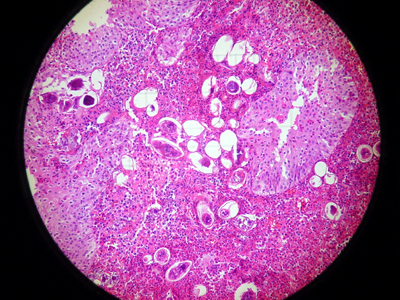Correct! We have yet another new hall of famer:
Hall of Fame
1) themule +2
1) cpants +2
1) Mr hawkings +2
4) Beachblonde +1
4) Whatayear +1
4) Bodonid +1
In an effort to establish some real ranking in the hall of fame, I am going to do a rapid fire round:
Mystery Pathogen #8 (no picture)
...This pathogen is part of a genus that contains 4 known species. It causes severe intestinal epithelium damage, resulting in bloody diarrhea. It also causes local inflammation by recruiting polymorphonucleocytes. Enters through M cells, and is taken up by macrophages. Induces apoptosis of host cell.
Mystery Pathogen #9 (no picture)
...This pathogen evades its degradation via macrophages by blocking phagolysosome formation. As part of a redundant immune evasion repertoire, this pathogen contains a 21 kDa lipoprotein that blocks MHC II expression.
Mystery Pathogen #10 (no picture)
...Transmitted by the kissing bug (triotomines).
Mystery Pathogen #11 (no picture)
...Gram negative bacteria. Causes upper respiratory tract infections and oitis in children. Can also cause meningitis. 1st bacterial genome to be sequenced.
Mystery Pathogen #12 (no picture)
...A patient comes into the hospital after doing missionary work in a West African village 2 weeks prior. They complain of abdominal pain, vomiting, diarrhea, and a sore throat. While doing an exam, you notice facial swelling, and what appears to be conjunctivitis. Labs come back, and one of the first things you notice is your patient has proteinuria. Unsure of what is going on, you go back to the room to get a more detailed history. When you come back, you notice that your patient's gums are starting to bleed.
Please be sure to specify which pathogen you are responding to.
Courtesy of the CDC and my brand new cellular microbiology book 🙂.







